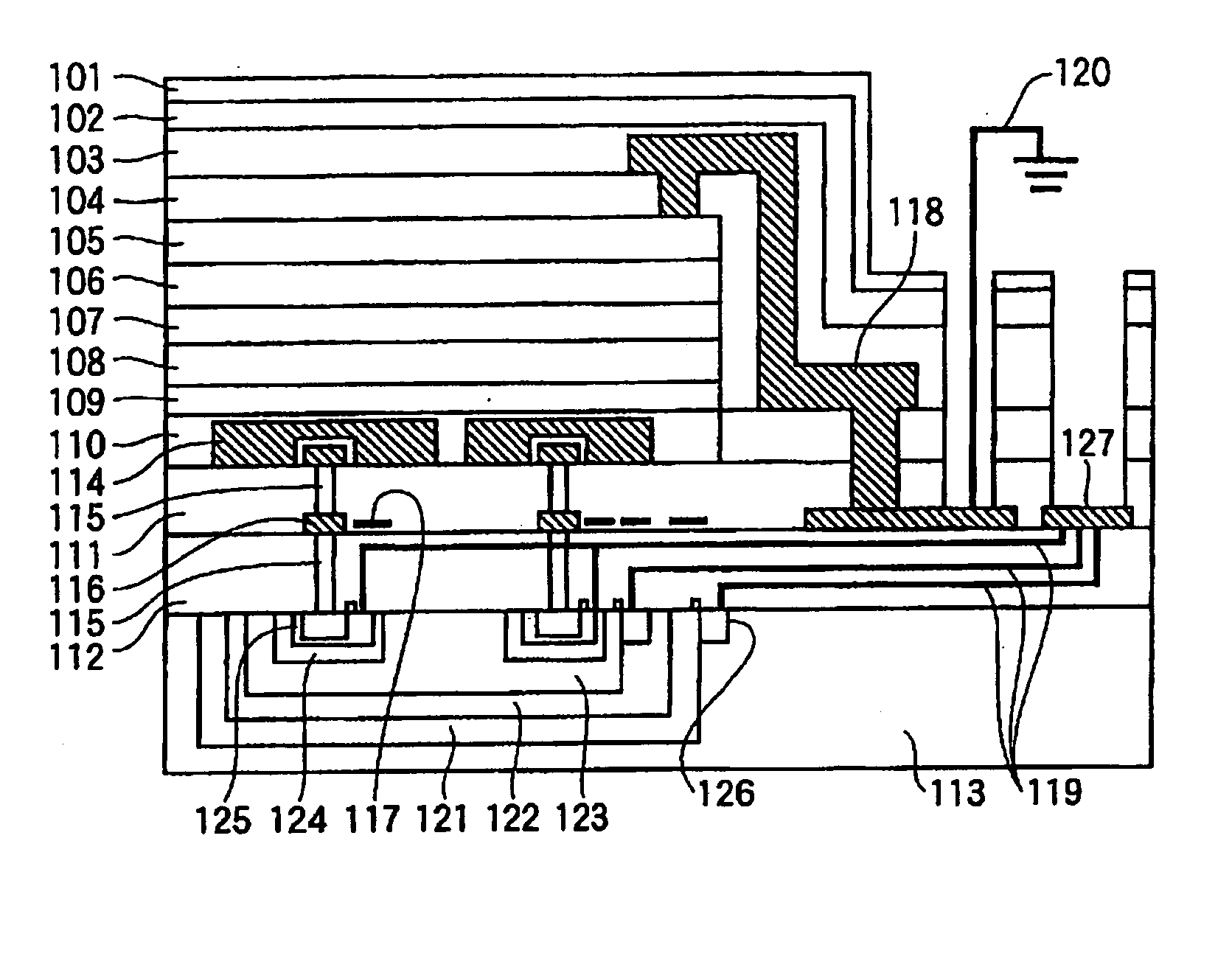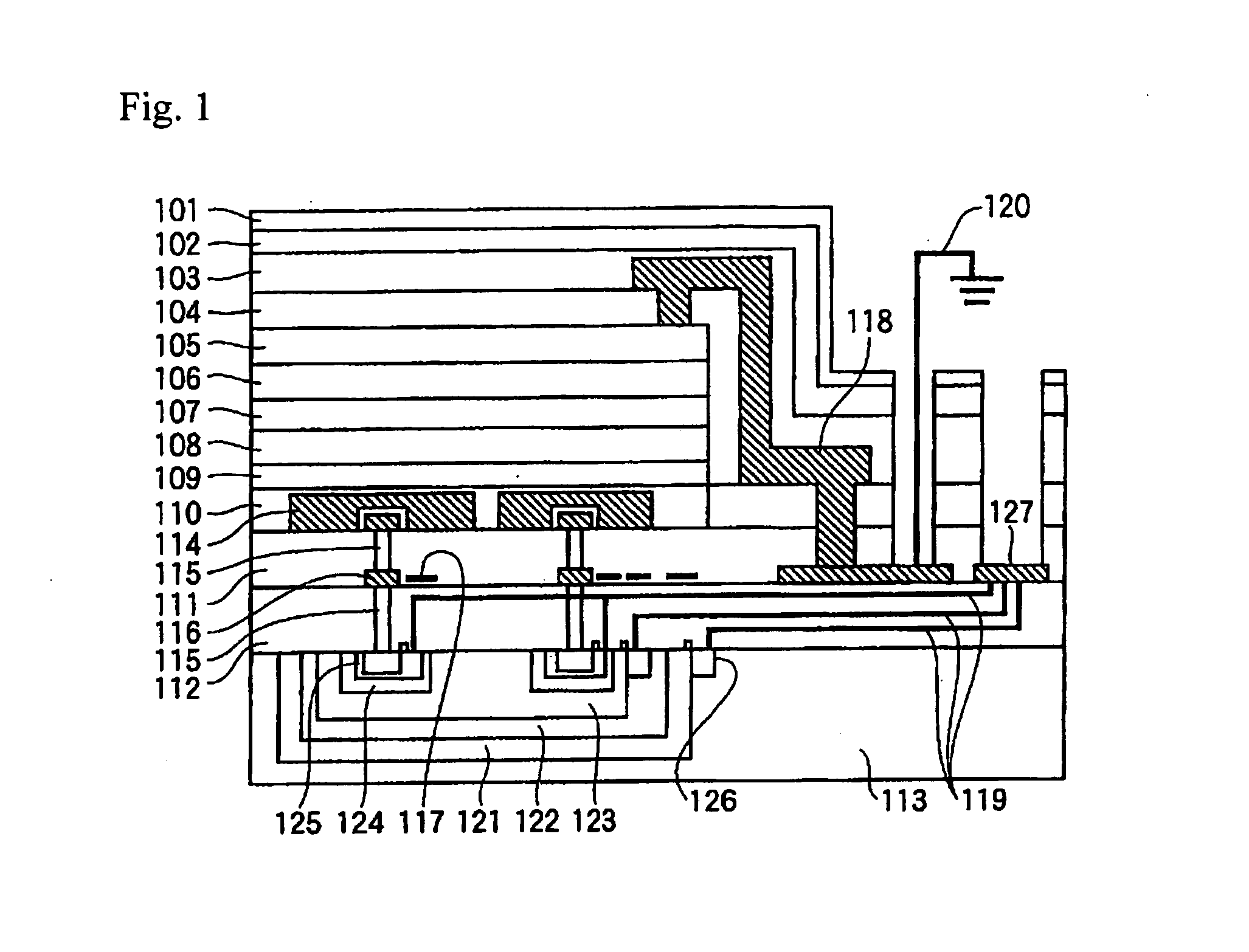[0018] The effect of the invention is remarkably revealed in the case where a minuter layer is applied as the transparent conducting
thin layer. It is thought that a transparent conducting
oxide (TCO) is preferable as the transparent conducting
thin layer because of its high light transmittance and low resistivity. In general, since in a transparent conducting
oxide (TCO) layer, a minute layer is formed against a
metal thin layer of Al, etc., the effect of the invention is remarkably revealed.
[0019] The effect of the invention is especially remarkable against a photoelectric conversion layer including a crystalline layer (namely,
grain boundary-containing layer) in which cracks are likely formed. In the case where an organic thin layer is applied as the photoelectric conversion layer, when a
pigment based material is contained in the photoelectric conversion layer, the effect of the invention is large. Furthermore, since the non-uniformity of the layer increases, when the thickness due to the
pigment based material increases, the effect of the invention becomes larger. In order to bring light absorption or sufficient photoelectric conversion performance, it is better that the thickness of the
pigment based material is thick within a certain range. The thickness of the pigment based material is preferably 75 nm or more, and more preferably 100 nm or more (preferably not more than 1,000 nm). The
grain boundary is confirmed by an
electron microscope or the like.
[0020] Examples of the pigment based material include usual pigments, namely organic pigments and
inorganic pigments. In the invention, such a material is a substance which is substantially insoluble in water or an
organic solvent and which is capable of forming the foregoing crystalline layer. Furthermore, even a substance which is soluble in water or an
organic solvent is included so far as it is used in a
solid state, thereby forming a crystalline layer. The pigment based material is preferably an organic pigment, and examples of the organic pigment include dyes as described later. That is, pigments among the p-type organic dyes or n-type organic dyes are preferably used.
[0021] In the case where an
organic layer is supposed as the photoelectric conversion layer, when the transparent conducting thin layer is subjected to film formation by a usual
sputtering method or the like, there is some possibility that the performance of the photoelectric conversion layer is deteriorated by the damage by
plasma. For that reason, the film formation of the transparent conducting thin layer is preferably carried out by a
plasma-free method. Here, the term “
plasma-
free state” means a state that plasma is not generated during the film formation of a transparent electrode layer, or a distance from the plasma generation source to the substrate is 2 cm or more, preferably 10 cm or more, and more preferably 20 cm or more and that the plasma which reaches the substrate is reduced.
[0022] Examples of a device in which plasma is not generated during the film formation of a transparent electrode layer include an
electron beam vapor deposition device (EB vapor deposition device) and a pulse
laser vapor deposition device. With respect to the EB vapor deposition device or pulse
laser vapor deposition device, devices as described in Developments of Transparent Conducting Films, supervised by Yutaka Sawada (published by CMC Publishing Co., Ltd., 1999); Developments of Transparent Conducting Films II, supervised by Yutaka Sawada (published by CMC Publishing Co., Ltd., 2002); Technologies of Transparent Conducting Films, written by Japan Society for the Promotion of Science (published by Ohmsha, Ltd., 1999); and references as added therein can be used. In the following, the method for achieving film formation of a transparent electrode film using an EB vapor deposition device is referred to as “EB vapor deposition method”; and the method for achieving film formation of a transparent electrode film using a pulse
laser vapor deposition device is referred to as “pulse laser vapor deposition method”.
[0023] With respect to the device capable of realizing the state that a distance from the plasma generation source to the substrate is 2 cm or more and that the plasma which reaches the substrate is reduced (hereinafter referred to as “plasma-free film formation device”), for example, a counter
target type sputtering device and an arc plasma vapor deposition method can be thought. With respect to these matters, devices as described in Developments of Transparent Conducting Films, supervised by Yutaka Sawada (published by CMC Publishing Co., Ltd., 1999); Developments of Transparent Conducting Films II, supervised by Yutaka Sawada (published by CMC Publishing Co., Ltd., 2002); Technologies of Transparent Conducting Films, written by Japan Society for the Promotion of Science (published by Ohmsha, Ltd., 1999); and references as added therein can be used.
 Login to View More
Login to View More  Login to View More
Login to View More 

